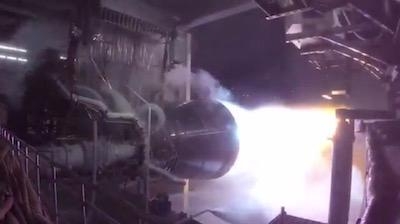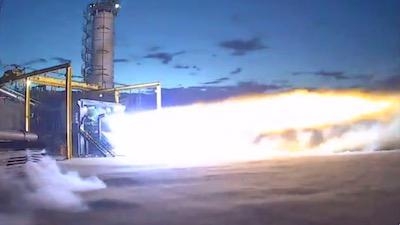Tue, Oct 24, 2017
Will Power The New Glenn Rocket, As Well As ULA Spacecraft
Blue Origin has successfully test-fired its BE-4 rocket engine at its facility in west Texas.

Geekwire reports that the engine, which is fueled by liquefied natural gas, was shipped from the manufacturing facility in Kent, WA to the test range in Texas. Jeff Bezos Tweeted on October 19 that the engine test-fire was a success.
The engine will power Blue Origin's orbital-class New Glenn rocket, which will be built at the company's factory in Florida near the Kennedy Space Center. That facility is expected to be completed by the end of the year. The New Glenn is scheduled for its first flight by 2020, and Blue Origin has already inked deals with several commercial customers for satellite launches that year. Bezos has said that he plans to bid for national security contracts, and hopes to be able to convince NASA to use the BE-4 to send spacecraft to the moon.
The company also has a contract with United Launch Alliance to supply engines for its new Vulcan rocket. That booster is expected to fly for the first time in 2019. It is designed to replace the Russian-made RD-180 engine that is currently used by some companies launching U.S. payloads into space.
The hot fire on October 19 did not reach full power, but was deemed successful nonetheless.

According to Blue Origin's website, BE-4 is the only engine that can fly by 2019, meeting the congressionally mandated deadline to eliminate dependence on Russian-built engines. The alternative engine option is multiple years behind and could not be integrated into a launch vehicle until at least 2021, extending our dependence on Russian engines well beyond 2019.
BE-4 is the only engine that can fly by 2019, meeting the congressionally mandated deadline to eliminate dependence on Russian-built engines. The alternative engine option is multiple years behind and could not be integrated into a launch vehicle until at least 2021, extending our dependence on Russian engines well beyond 2019.
(Images from video Tweeted by Jeff Bezos)
More News
From 2023 (YouTube Version): Legacy of a Titan Robert (Bob) Anderson Hoover was a fighter pilot, test pilot, flight instructor, and air show superstar. More so, Bob Hoover was an i>[...]
Get The Latest in Aviation News NOW on Instagram Are you on Instagram yet? It's been around for a few years, quietly picking up traction mostly thanks to everybody's new obsession >[...]
Aero Linx: B-52H Stratofortress The B-52H Stratofortress is a long-range, heavy bomber that can perform a variety of missions. The bomber is capable of flying at high subsonic spee>[...]
Altimeter Setting The barometric pressure reading used to adjust a pressure altimeter for variations in existing atmospheric pressure or to the standard altimeter setting (29.92).>[...]
"Knowing that we play an active part in bettering people's lives is extremely rewarding. My team and I are very thankful for the opportunity to be here and to help in any way we ca>[...]
 Classic Aero-TV: Remembering Bob Hoover
Classic Aero-TV: Remembering Bob Hoover ANN FAQ: Follow Us On Instagram!
ANN FAQ: Follow Us On Instagram! ANN's Daily Aero-Linx (05.15.24)
ANN's Daily Aero-Linx (05.15.24) ANN's Daily Aero-Term (05.15.24):Altimeter Setting
ANN's Daily Aero-Term (05.15.24):Altimeter Setting Aero-News: Quote of the Day (05.16.24)
Aero-News: Quote of the Day (05.16.24)




